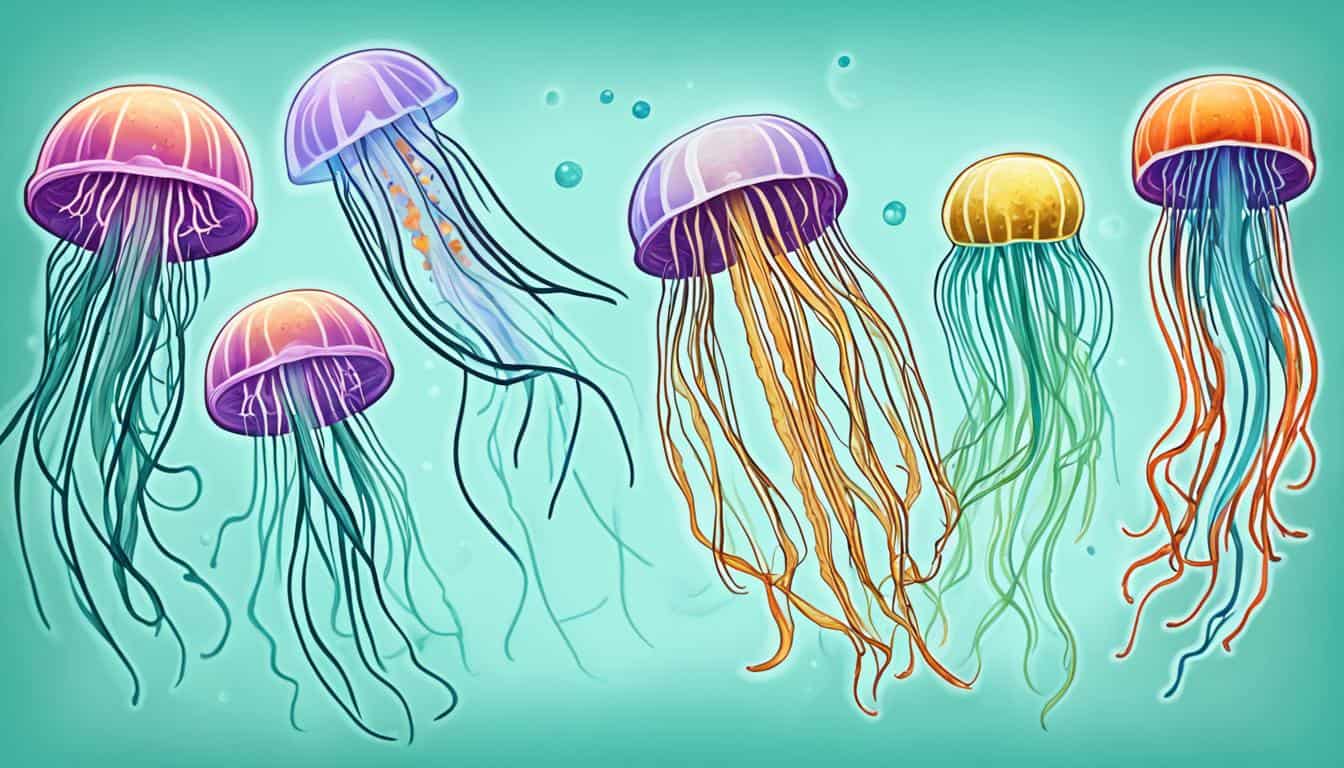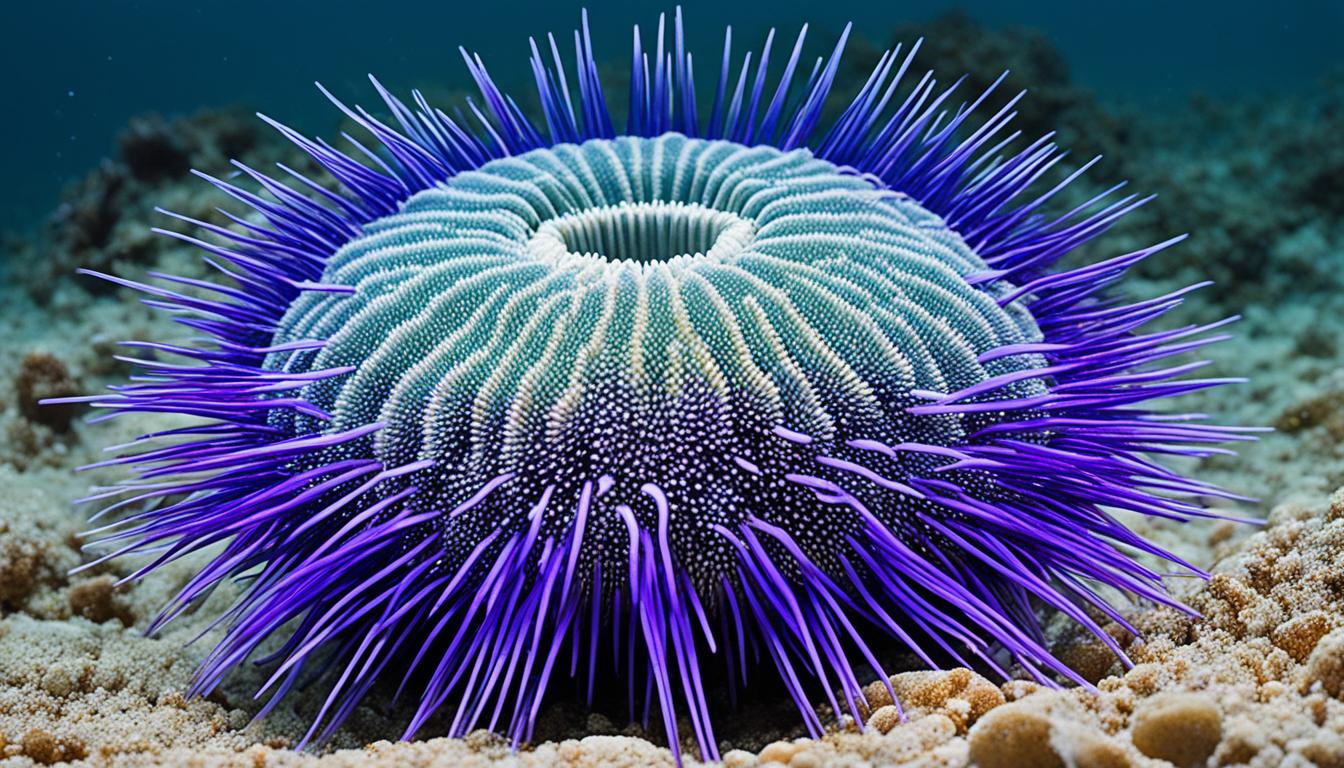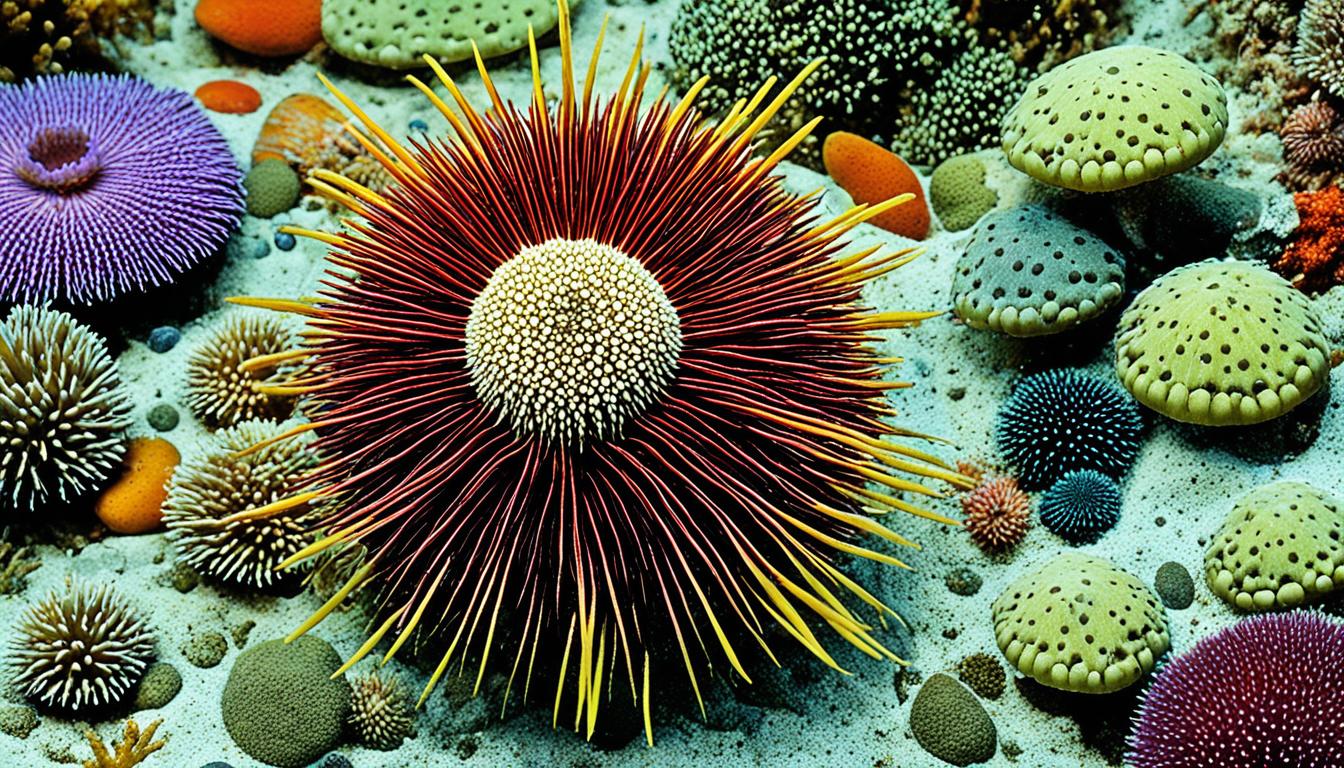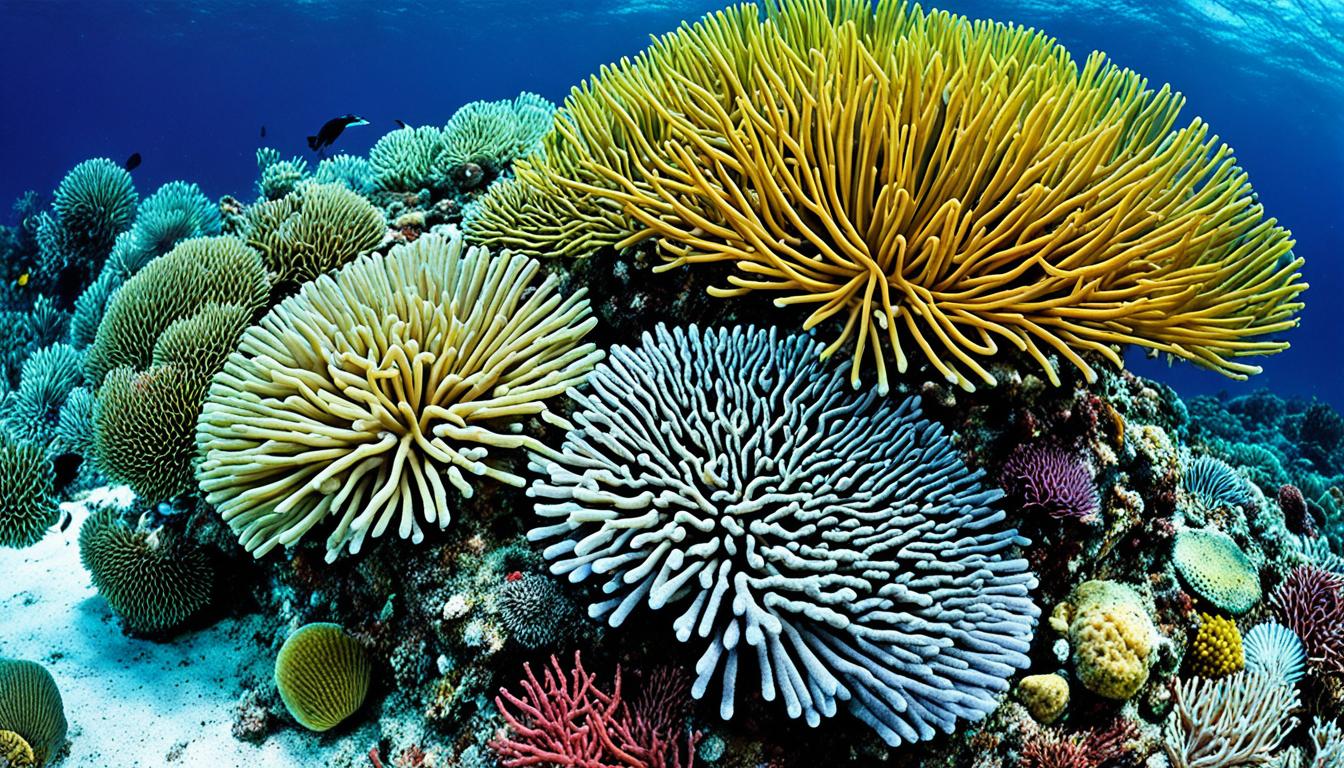Learning about how long jellyfish live is key to understanding their role in the ocean. Jellyfish lifespans differ greatly among species, influenced by their environment and life stages. This piece will explore the amazing life cycle of jellyfish, from polyp to medusa, and their crucial role in ocean food chains.
Understanding Jellyfish Lifespan
To understand jellyfish lifespan, we must see their role in marine ecosystems. These creatures play a big part in their environments and the lives of other marine animals. Their survival time affects how they help with nutrient cycling and as food for bigger sea creatures.
The Importance of Jellyfish in Marine Ecosystems
Jellyfish are key to their habitats. They are both hunters and hunted, playing a big role in marine food chains. Their numbers can change the populations of plankton and small fish, shaping the ecosystem.
Factors Influencing Jellyfish Longevity
Many things affect how long jellyfish live and their overall life span. Things like water temperature, salt levels, and pollution can change their lives. Food availability is also key, as it helps them grow and reproduce. A good food supply means they can live longer and do well in different ocean places.
Jellyfish Life Cycle Stages
The life cycle of jellyfish is filled with interesting stages. Each stage has its own traits and importance. They start as polyps and grow into medusas, which is the adult form.
Polyps: The Early Life of a Jellyfish
Jellyfish begin as larvae that stick to the ocean floor. They can make more polyps without sex. These polyps can stay dormant for a long time, helping them survive tough times.
Medusa Stage: The Adult Life of a Jellyfish
When jellyfish turn into medusas, they become free and can have sex. This change is key for their survival and keeping their species going. As adults, they can move around and live longer.
Transformation from Polyp to Medusa
Changing from a polyp to a medusa is a big step in their life. This change happens based on the environment. When things are good, polyps turn into medusas, which helps them keep their life cycle going.
| Stage | Description | Typical Duration | Reproductive Method |
|---|---|---|---|
| Polyp | Fixed stage; can reproduce asexually | Variable (years possible) | Asexual reproduction |
| Medusa | Free-floating adult stage | Several months to a few years | Sexual reproduction |
How Long Do Jellyfish Live?
Jellyfish have different lifespans, making people ask, how long do jellyfish live? Their varied lives show how adaptable and resilient they are.
Average Lifespans by Species
Different jellyfish species have different lifespans. Some live short lives, while others can live for years. For example, the cannonball jellyfish lives about three to six months. But the lion’s mane jellyfish can live several years.
This difference in lifespan comes from many factors, like biology and the environment.
Impact of Environmental Conditions on Lifespan
Knowing how long jellyfish live also means understanding their environment. Things like temperature, food, and pollution affect their lifespan.
Warm waters can help them grow faster but also stress them out. Having plenty of food helps them live longer. By watching these factors, we can learn more about their lives in the ocean.
Jellyfish Species and Their Lifespan
There are many types of jellyfish, each with its own lifespan. The jellyfish lifespan can vary a lot. Some live short lives, while others can live for years. This shows how different they are from each other.
Variations Across Different Species
Some jellyfish don’t live more than a few months. Others can live for years. This difference tells us a lot about their lives. For example, the Turritopsis dohrnii, also called the “immortal jellyfish,” can go back to its early stage. This lets it live longer under the right conditions.
Examples of Lifespans in Notable Jellyfish
Let’s look at some well-known jellyfish and how long they live:
| Jellyfish Species | Average Lifespan |
|---|---|
| Moon Jellyfish (Aurelia aurita) | 1 year |
| Immortal Jellyfish (Turritopsis dohrnii) | Indefinite |
| Lion’s Mane Jellyfish (Cyanea capillata) | Up to 5 years |
| Box Jellyfish (Chironex fleckeri) | 1 year |

These jellyfish show us the wide range of lifespans in the jellyfish world. Each one has special traits that help it live longer. Learning about them helps us understand their role in the ocean.
Jellyfish Survival Time and Environmental Factors
The survival time of jellyfish depends a lot on their environment. This includes things like how much food they have and the temperature. These factors are key to how long jellyfish live, affecting their growth and ability to reproduce.
The Role of Food Availability and Temperature
Jellyfish eat small fish and plankton. Without enough food, they get sick and don’t live as long. Temperature is also very important. It can make them grow faster in warm water, but too much heat can stress them out and kill them.
Predation and Its Effect on Jellyfish Longevity
Sea turtles and some fish eat jellyfish, which is a big threat to them. This can really cut down the number of jellyfish in an area. Knowing about these threats helps us protect jellyfish and their homes.
| Environmental Factor | Impact on Survival |
|---|---|
| Food Availability | Essential for growth and reproduction; insufficient food shortens jellyfish survival period. |
| Temperature | Influences metabolic rates; optimal temperatures enhance survival and growth. |
| Predation | Increases mortality rates among jellyfish populations, significantly affecting longevity. |
Jellyfish Longevity: Myths and Facts
Many myths surround the longevity of jellyfish, making it hard to see the truth about these creatures. One common myth is that all jellyfish live forever. This idea comes from some species, like the “Immortal Jellyfish,” which can go back to its early stage under certain conditions. But, this doesn’t mean all jellyfish can do this, and most have a set lifespan.
Jellyfish lifespans differ greatly across species and are affected by things like temperature and food. Many jellyfish face dangers from predators and changes in their homes, which can shorten their lives. Some may live just a few months, while others can live for years if things are right for them. This shows how complex life can be for jellyfish in the ocean.
Knowing the truth about jellyfish longevity helps us understand how these creatures survive in the ocean. By seeing how different things affect their lives and the special ways some species adapt, we get a better view of jellyfish beyond the myths.
FAQ
How long do jellyfish live?
Jellyfish live for different lengths of time. Some, like the cannonball jellyfish, live only three to six months. Others, such as the lion’s mane jellyfish, can live for years.
What factors influence jellyfish longevity?
Many things affect how long jellyfish live. These include their environment, the food they find, pollution, and being eaten by other sea creatures. These factors are key to their survival.
What are the life stages of a jellyfish?
Jellyfish go through two main life stages. The first is the polyp stage, which is asexual and can stay dormant. The second is the medusa stage, where they reproduce sexually. This change helps them keep their species going.
Can jellyfish be immortal?
Some jellyfish, like the immortal jellyfish, can turn back into their young form. This lets them avoid aging. But not all jellyfish can do this, and many face threats from their environment that shorten their lives.
What is the average lifespan of different jellyfish species?
Jellyfish live for varying lengths of time. For example, the moon jellyfish lives about a year. The immortal jellyfish, on the other hand, can live forever under the right conditions. This shows how different jellyfish can live.
How does food availability affect jellyfish lifespan?
Jellyfish need enough food, like small fish and plankton, to survive and grow. If they don’t get enough food, they may live shorter lives and have fewer babies.
What role does temperature play in jellyfish longevity?
Temperature changes can affect how jellyfish grow and live. They need the right temperature to survive and have babies. The right temperature is key for their life cycle.
Are there common myths about jellyfish longevity?
Yes, some people think all jellyfish live forever, because some species can turn back into young ones. But, many jellyfish don’t live forever because they face dangers and environmental challenges.










